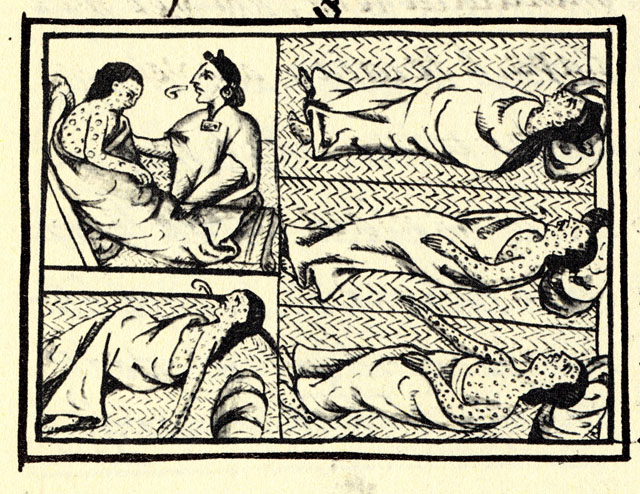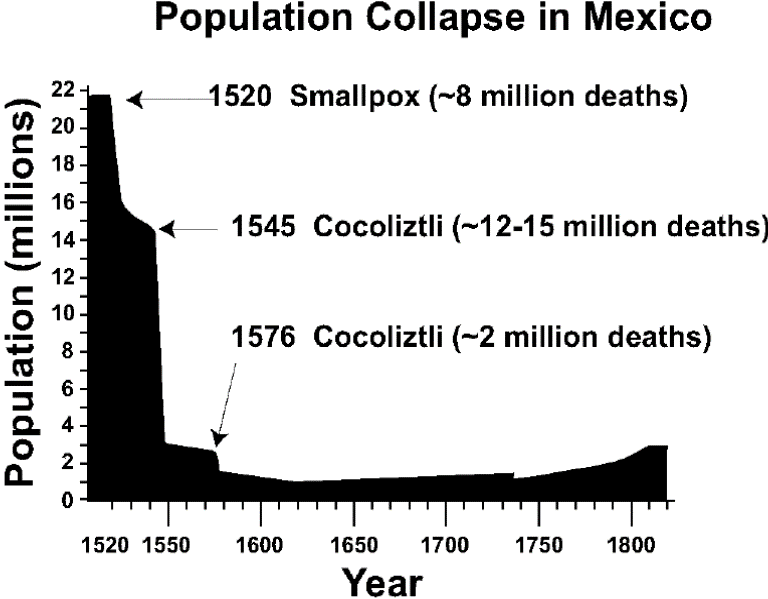|
Cocoliztli
The Cocoliztli Epidemic or the Great Pestilence was an outbreak of a mysterious illness characterized by high fevers and bleeding which caused 5â15 million deaths in New Spain during the 16th century. The Aztec people called it ''cocoliztli'', Nahuatl for pestilence. It ravaged the Mexican highlands in epidemic proportions, resulting in the demographic collapse of some Indigenous populations. Based on the death toll, this outbreak is often referred to as the worst epidemic in the history of Mexico. Subsequent outbreaks continued to baffle both Spanish and native doctors, with little consensus among modern researchers on the pathogenesis. However, recent bacterial genomic studies have suggested that Salmonella, specifically a serotype of ''Salmonella enterica'' known as Paratyphi C, was at least partially responsible for this initial outbreak. Others believe ''cocoliztli'' was caused by an indigenous viral hemorrhagic fever, perhaps exacerbated by the worst droughts to affect ... [...More Info...] [...Related Items...] OR: [Wikipedia] [Google] [Baidu] |
Viral Hemorrhagic Fever
Viral hemorrhagic fevers (VHFs) are a diverse group of diseases. "Viral" means a health problem caused by infection from a virus, " hemorrhagic" means to bleed, and "fever" means an unusually high body temperature. Bleeding and fever are common signs of VHFs, which is how the group of infections got its common name. There are five known families of RNA viruses which cause VHFs: '' Arenaviridae'', '' Filoviridae'', '' Flaviviridae'', '' Hantaviridae'', and ''Rhabdoviridae''. Some VHFs are usually mild, such as nephropathia epidemica (within the family ''Hantaviridae''). But some are usually severe and have a high death rate, such as Ebola virus (within the family ''Filoviridae''). All VHFs can potentially cause severe blood loss, high fever, and death. Both humans and non human animals can be infected. Signs and symptoms The following are signs and symptoms of most or all VHFs. * Circulatory shock *Diarrhea (feces which resemble more liquid than solid) *Headache *Hypotens ... [...More Info...] [...Related Items...] OR: [Wikipedia] [Google] [Baidu] |
Salmonella Enterica
''Salmonella enterica'' (formerly ''Salmonella choleraesuis'') is a rod-shaped, flagellate, facultative anaerobic, Gram-negative bacterium and a species of the genus ''Salmonella''. It is divided into six subspecies, arizonae (IIIa), diarizonae (IIIb), houtenae (IV), salamae (II), indica (VI), and enterica (I). A number of its serovars are serious human pathogens; many of them are (more specifically) serovars of ''Salmonella enterica'' subsp. ''enterica''. Epidemiology Most cases of salmonellosis are caused by food infected with ''S. enterica'', which often infects cattle and poultry, though other animals such as domestic cats and hamsters have also been shown to be sources of infection in humans. It primarily resides in the intestinal tract of animals and humans and can be found in feedstuff, soil, bedding, litter, and fecal matter. The primary reservoir for the pathogen is poultry and 70% of human cases are attributed to the consumption of contaminated eggs, chicken, or ... [...More Info...] [...Related Items...] OR: [Wikipedia] [Google] [Baidu] |
New Spain
New Spain, officially the Viceroyalty of New Spain ( ; Nahuatl: ''Yankwik Kaxtillan Birreiyotl''), originally the Kingdom of New Spain, was an integral territorial entity of the Spanish Empire, established by Habsburg Spain. It was one of several domains established during the Spanish colonization of the Americas, Spanish conquest of the Americas, and had its capital in Mexico City. Its jurisdiction comprised a large area of the southern and western portions of North America, mainly what became Mexico and the Southwestern United States, but also California, Florida and Louisiana (New Spain), Louisiana; Central America as Mexico, the Caribbean like Hispaniola and Martinique, Martinica, and northern parts of South America, even Colombia; several Pacific archipelagos, including the Philippines and Guam. Additional Asian colonies included "Spanish Formosa", on the island of Taiwan. After the 1521 Spanish conquest of the Aztec Empire, conqueror Hernån Cortés named the territory New S ... [...More Info...] [...Related Items...] OR: [Wikipedia] [Google] [Baidu] |
Spanish Conquest Of The Aztec Empire
The Spanish conquest of the Aztec Empire was a pivotal event in the history of the Americas, marked by the collision of the Aztec Triple Alliance and the Spanish Empire. Taking place between 1519 and 1521, this event saw the Spanish conquistador HernĂĄn CortĂ©s, and his small army of European soldiers and numerous indigenous allies, overthrowing one of the most powerful empires in Mesoamerica. Led by the Aztec ruler Moctezuma II, the Aztec Empire had established dominance over central Mexico through military conquest and intricate alliances. Because the Aztec Empire ruled via hegemonic control by maintaining local leadership and relying on the psychological perception of Aztec power â backed by military force â the Aztecs normally kept subordinate rulers compliant. This was an inherently unstable system of governance, as this situation could change with any alteration in the status quo. A combination of factors including superior weaponry, strategic alliances with oppresse ... [...More Info...] [...Related Items...] OR: [Wikipedia] [Google] [Baidu] |
Salmonella
''Salmonella'' is a genus of bacillus (shape), rod-shaped, (bacillus) Gram-negative bacteria of the family Enterobacteriaceae. The two known species of ''Salmonella'' are ''Salmonella enterica'' and ''Salmonella bongori''. ''S. enterica'' is the type species and is further divided into six subspecies that include over 2,650 serotypes. ''Salmonella'' was named after Daniel Elmer Salmon (1850â1914), an American veterinary surgeon. ''Salmonella'' species are non-Endospore, spore-forming, predominantly motility, motile enterobacteriaceae, enterobacteria with cell diameters between about 0.7 and 1.5 micrometre, ÎŒm, lengths from 2 to 5 ÎŒm, and peritrichous flagella (all around the cell body, allowing them to move). They are chemotrophs, obtaining their energy from Redox, oxidation and reduction reactions, using organic sources. They are also facultative aerobic organism, facultative anaerobes, capable of generating adenosine triphosphate with oxygen ("aerobically") ... [...More Info...] [...Related Items...] OR: [Wikipedia] [Google] [Baidu] |
Toribio De Benavente Motolinia
Toribio of Benavente (1482, Benavente, Spain â 1565, Mexico City, New Spain), also known as MotolinĂa, was a Franciscan missionary who was one of the famous Twelve Apostles of Mexico who arrived in New Spain in May 1524. His published writings are a key source for the history and ethnography of the Nahuas of central Mexico in the immediate post-conquest period as well as for the challenges of Christian evangelization. He is probably best known for his attacks on the Dominican defender of the rights of the indigenous peoples, BartolomĂ© de las Casas, who criticized the Conquest. Though agreeing with Las Casas's criticism of the abuses of the conquistadors, he did not agree with the wholesale condemnation of the Spanish Conquest, as well as criticisms of the Franciscan practice of baptism ''en masse'' of the indigenous people of the new world. Due to these differences he went on to vilify Las Casas. Early life Toribio entered the Franciscan Order at the age of seventeen, dropp ... [...More Info...] [...Related Items...] OR: [Wikipedia] [Google] [Baidu] |
Bernardino De SahagĂșn
Bernardino de SahagĂșn ( â 5 February 1590) was a Franciscan friar, missionary priest and pioneering ethnographer who participated in the Catholic evangelization of colonial New Spain (now Mexico). Born in SahagĂșn, Spain, in 1499, he journeyed to New Spain in 1529. He learned Nahuatl and spent more than 50 years in the study of Aztec beliefs, culture and history. Though he was primarily devoted to his missionary task, his extraordinary work documenting indigenous worldview and culture has earned him the title as "the first anthropologist."Arthur J.O. Anderson, "SahagĂșn: Career and Character" in Bernardino de SahagĂșn, ''Florentine Codex: The General History of the Things of New Spain, Introductions and Indices'', Arthur J.O. Anderson and Charles Dibble, translators. Salt Lake City: University of Utah Press 1982, p. 40.M. LeĂłn-Portilla, Bernardino de SahagĂșn: The First Anthropologist' (University of Oklahoma Press, Norman, 2002), pp. He also contributed to the description ... [...More Info...] [...Related Items...] OR: [Wikipedia] [Google] [Baidu] |
Reducciones
Reductions (, also called ; ) were settlements established by Spanish rulers and Roman Catholic missionaries in Spanish America and the Spanish East Indies (the Philippines). In Portuguese-speaking Latin America, such reductions were also called ''aldeias''. The Spanish and Portuguese relocated, forcibly in many cases, indigenous inhabitants (''Indians'' or ''Indios'') of their colonies into urban settlements modeled on those in Spain and Portugal. The Royal Academy of Spain defines (reduction) as "a grouping into settlement of indigenous people for the purpose of evangelization and assimilation." In colonial Mexico, reductions were called "congregations" (''congregaciones''). Forced resettlements aimed to concentrate indigenous people into communities, facilitating civil and religious control over populations. The concentration of the indigenous peoples into towns facilitated the organization and exploitation of their labor. The practice began during Spanish colonization ... [...More Info...] [...Related Items...] OR: [Wikipedia] [Google] [Baidu] |
New World Rats And Mice
The New World rats and mice are a group of related rodents found in North and South America. They are extremely diverse in appearance and ecology, ranging from the tiny '' Baiomys'' to the large '' Kunsia''. They represent one of the few examples of muroid rodents (along with the voles) in North America, and the only example of muroid rodents to have made it into South America. The New World rats and mice are often considered part of a single subfamily, Sigmodontinae, but the recent trend among muroid taxonomists is to recognize three separate subfamilies. This strategy better represents the extreme diversity of species numbers and ecological types. Some molecular phylogenetic studies have suggested that the New World rats and mice are not a monophyletic group, but this is yet to be confirmed. Their closest relatives are clearly the hamsters and voles. The New World rats and mice are divided into 3 subfamilies, 12 tribes, and 84 genera. Classification *Family Cricetida ... [...More Info...] [...Related Items...] OR: [Wikipedia] [Google] [Baidu] |
Virgin Soil Epidemic
In epidemiology, a virgin soil epidemic is an epidemic in which populations that previously were in isolation from a pathogen are immunologically unprepared upon contact with the novel pathogen. Virgin soil epidemics have occurred with European settlement, particularly when European explorers and colonists took diseases to lands they settled in the Americas, Australia and Pacific Islands. When a population has been isolated from a particular pathogen without any contact, individuals in that population have not built up any immunity to that organism and also have not received immunity passed from mother to child. The epidemiologist Francis Black has suggested that some isolated populations may not have mixed enough to become as genetically heterogeneous as their colonizers, which would also have affected their natural immunity, due to the potential benefits to immune system function due to genetic diversity. That can happen also when such a considerable amount of time has passed ... [...More Info...] [...Related Items...] OR: [Wikipedia] [Google] [Baidu] |




